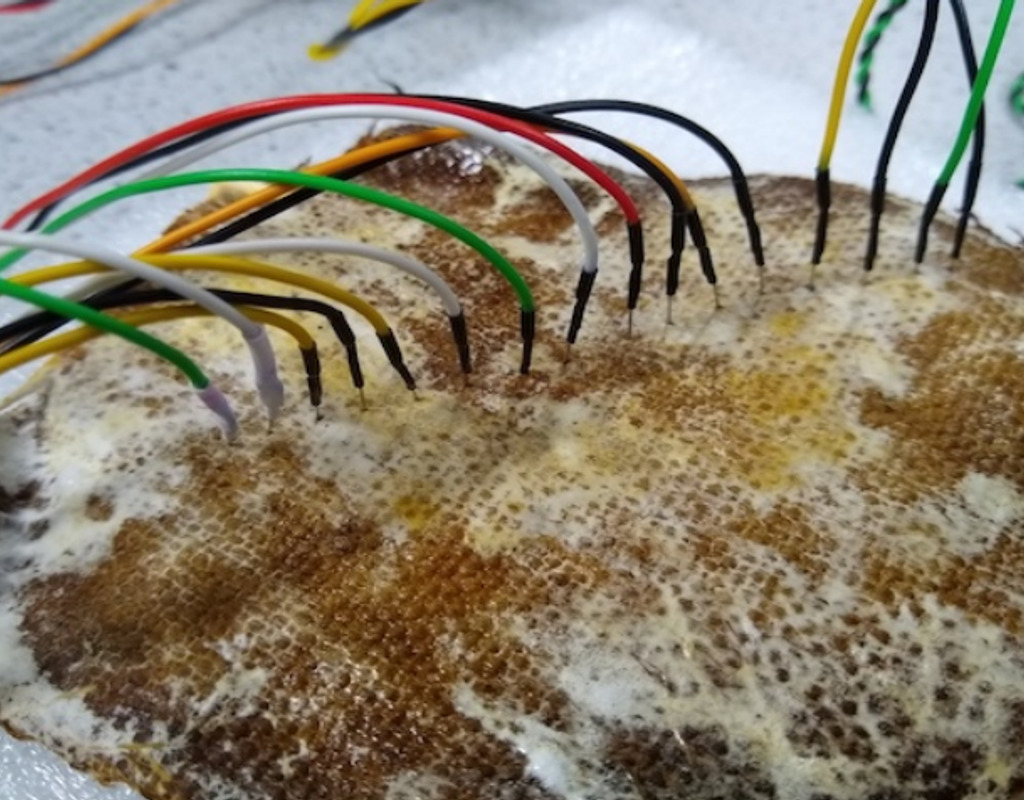4 Mins Read
In a recent study titled ‘Reactive fungal wearable‘, researchers explore the use of fungi as a potential candidate to produce sustainable textiles that can be used as eco-friendly bio wearables, for instance, the processors in tech wearables like Fitbits could be replaced by incorporating mushroom mycelium.
The joint research venture undertaken by the University of the West of England, Bristol, the U.K. (UWE Bristol) and collaborators from Mogu S.r.l., Italy, Istituto Italiano di Tecnologia, Torino, Italy and the Faculty of Computer Science, Multimedia and Telecommunications of the Universitat Oberta de Catalunya (UOC) has assessed the sensing potential of fungal wearables.
The researchers of the study conducted several laboratory experiments on the electrical response of a hemp fabric captured by oyster fungi by attaching it to computer sensors and stimulating it with attractants and repellents.
Wearable devices require complex and sophisticated circuits that connect to sensors having at least some computing power, thus making them ‘smart’.
Oyster mushroom mycelium, the fibrous mainframe tissues of fungi that populate under the soil and from which mushrooms sprout was able to perceive several external stimuli like light, temperature, and moisture, as well as certain chemicals in the environment, and even electrical signals in a way that imitates the same function for sensors and processors.
To explain this concept further, we use an example of a heart rate monitor, and using the study’s findings, the mushroom’s perceptions of the environment would become the data that gives you the beats-per-minute count on this device.
Dr. Mohammad Mahdi Dehshibi, researcher with the UOC’s Scene Understanding and Artificial Intelligence Lab (SUNAI), an author of the study said that fungi make up the largest, most widely distributed and oldest group of living organisms on the planet. “They grow extremely fast and bind to the substrate you combine them with and are even able to process information in a way that resembles computers. We can reprogramme a geometry and graph-theoretical structure of the mycelium networks and then use the fungi’s electrical activity to realize computing circuits. Fungi do not only respond to stimuli and trigger signals accordingly, but also allow us to manipulate them to carry out computational tasks, in other words, to process information.”

into real cloth and locations of electrodes. Source: ‘Reactive fungal wearable’ study
Fungi make up the largest, most widely distributed and oldest group of living organisms on the planet. They grow extremely fast and bind to the substrate you combine them with and are even able to process information in a way that resembles computers. We can reprogramme a geometry and graph-theoretical structure of the mycelium networks and then use the fungi’s electrical activity to realize computing circuits
Dr. Mohammad Mahdi Dehshibi, author on the study
Prof. Andrew Adamtzky from UWE Bristol’s Unconventional Computing Laboratory, another author on this study and who famously utilized slime molds to solve mazes and optimize city roadway planning in Tokyo and France, wrote in his new research paper. “We have shown that it is possible to discern a nature of stimuli from the fungi electrical responses. The results paved a way towards the future design of intelligent sensing patches to be used in reactive fungal wearables.”
By nature, mycelium organizes itself into geometric structures in and throughout the soil and though fungal mycelium doesn’t have many reasons for recognizing electrical signals in nature that we know of and Prof. Adamtzky wants to investigate whether reprogramming oyster mushroom mycelium genes to develop into different geometric structures would optimize the detection power of electrical signals.
According to Dehshibi, mycelium-based products are already used commercially in construction. “You can mold them into different shapes like you would with cement, but to develop a geometric space you only need between five days and two weeks. They also have a small ecological footprint. In fact, given that they feed on waste to grow, they can be considered environmentally friendly.”
With this study’s findings, the authors of the paper don’t mean to replace silicon chips- fungal reactions are too slow for that. Rather, they think that the findings could help humans use mycelium growing in an ecosystem as a ‘large-scale environmental sensor’ as fungal networks, are monitoring a large number of data streams as part of their everyday existence and if we could plug into mycelial networks and interpret the signals, they use to process information, individuals could learn more about what was happening in an ecosystem.
Mycelium can be used to make building bricks, coffins, canoes and there are several companies that are understanding the multifaceted uses of mushroom mycelium and incorporating it into their products. For instance, NetZero has developed a new type of ‘mushroom ball’ or orbs that leverage the carbon-sequestration ability of mycelium, derived from fungi, and can speed up the environment’s natural carbon capture rate by two-fold thus empowering individuals to capture carbon from their backyard.
In the fashion industry, alt material startup Mycoworks recently bagged US$45 million in funding to use a mycelium-based material that can replace both emissions-heavy traditional cowhide as well as petroleum-based plastic vegan leathers.
Even the food industry has come forward and recognized the potential of this fungi with New Singularity, a plant-based seafood company based in mainland China developing their “1.0” microalgae-based vegan seafood analogues that will incorporate a mycelium fermentation technology to create their second iteration of seafood analogues.
Lead image – Experimental setup, courtesy of ‘Reactive fungal wearable’ study.



